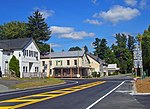Kobelt Airport
Airports in New York (state)Transportation buildings and structures in Ulster County, New York
Kobelt Airport (FAA LID: N45) is a privately owned, public use airport in Ulster County, New York, United States. It is located three nautical miles (6 km) northeast of the central business district of Wallkill and is also known as Kobelt/Wallkill Airport. This airport is included in the National Plan of Integrated Airport Systems for 2011–2015, which categorized it as a general aviation reliever airport.Although most U.S. airports use the same three-letter location identifier for the FAA and IATA, this airport is assigned N45 by the FAA but has no designation from the IATA.
Excerpt from the Wikipedia article Kobelt Airport (License: CC BY-SA 3.0, Authors).Kobelt Airport
Alpine Lane, Town of Shawangunk
Geographical coordinates (GPS) Address Nearby Places Show on map
Geographical coordinates (GPS)
| Latitude | Longitude |
|---|---|
| N 41.627777777778 ° | E -74.133888888889 ° |
Address
Alpine Lane 23
12589 Town of Shawangunk
New York, United States
Open on Google Maps







